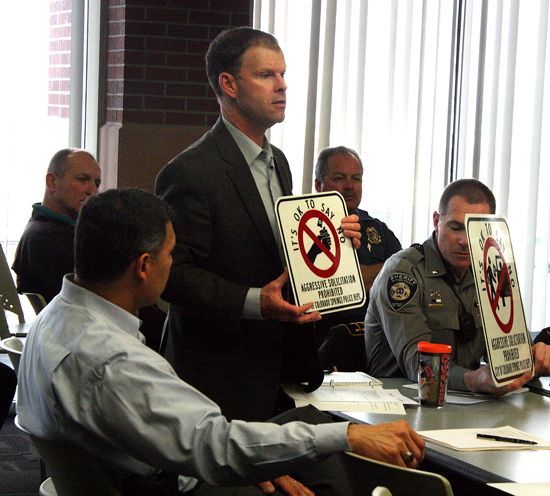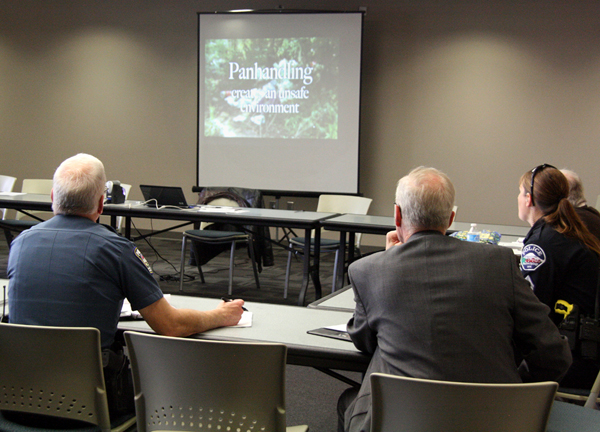'It's OK to say no' to panhandlers - new signs, video unveiled at ATF meeting
Signs alerting people to the drawbacks of giving money to panhandlers will be posted soon in the downtown and are being made available to entities on the Westside.The signs were created by the Colorado Springs Police Department, with input from the Avenue Task Force (ATF). An ad hoc group formed two years ago, the ATF includes Westside residents who work with law enforcement
 Police Lt. Jeff Jensen (standing) and El Paso
County Sheriff's Lt. J.D. Ross display signs intended to discourage people from
giving money to panhandlers. The unveiling took place during a March 19 meeting
of the Avenue Task Force in the Gold Hill Police Station community room.
Seated
to Jensen's right is Gold Hill Commander Rafael Cintron.
Police Lt. Jeff Jensen (standing) and El Paso
County Sheriff's Lt. J.D. Ross display signs intended to discourage people from
giving money to panhandlers. The unveiling took place during a March 19 meeting
of the Avenue Task Force in the Gold Hill Police Station community room.
Seated
to Jensen's right is Gold Hill Commander Rafael Cintron.
Westside Pioneer photo
|
Unveiled at the March 19 ATF meeting, the signs come in two rectangular sizes - one 18 inches high, the other one 12 inches. Both bear the messages “It's OK to say no” and “Aggressive solicitation prohibited.”
A graphic on the larger version shows someone in a car reaching through a car window to give a person cash. But a red circle encompasses the graphic, with a diagonal red line across it in the universal negation symbol.
On the smaller sign, a similar red line runs across a different graphic - one that displays a piece of paper money next to a hand clutching what could be an alcoholic drink.
The term, “aggressive solicitation,” refers to people using physical or verbal intimidation when they seek a handout. Even asking a second time after being turned down is a violation of city codes.
The sign plan was motivated by city findings about an all-too-frequent unintended outcome when well-meaning people give beggars money: They use it to buy liquor or drugs. This in turn can lead to their becoming incapacitated and requiring emergency treatment at taxpayer expense. “We have spent as much as $57,000 on a single hospital visit,” comments Police Sergeant Michael Spitzmiller in a 12-minute panhandling video produced by the El Paso County Public Information Office.
At the same time, Gold Hill Police Commander Rafael Cintron explained that for legal reasons the signs cannot leave the impression that panhandling is against the law. The practice is allowed in most public places - such as the sidewalks at shopping center accesses - and even on private property, unless the land owner seeks trespassing charges, he pointed out.
Police also emphasize the efforts they take to assist people who are genuinely down and out, using a special unit called the Homeless Outreach (“HOT”) team.
At the ATF meeting, Gold Hill Police Lieutenant Jeff Jensen said final
 Several members of the Avenue Task Force
March 19 watch a screening of a new video explaining the downside of giving
money to panhandlers.
Several members of the Avenue Task Force
March 19 watch a screening of a new video explaining the downside of giving
money to panhandlers.
Westside Pioneer photo
|
Downtown merchants have frequently complained that vagrancy hurts business, and two years ago they won City Council approval for a law (later deemed unconstitutional) to curb panhandling in a defined downtown area.
On the Westside, Jensen said that “most problem areas are on private property.” Because of that, the plan is for citizen members of the ATF to seek permission from private property owners to put up the signs at strategic Westside locations.
Among those in attendance at the ATF meeting was Dave Van Ness, executive director of the Old Colorado City Associates (OCCA) business group, who expressed interest in installing one or more of the signs in Bancroft Park.
The sign costs are $35 for the larger size and $15 for the smaller, said Mary Gallivan, a citizen volunteer on the ATF.
Like the signs, the panhandling video was also unveiled at the March 19 ATF meeting. ATF members hope to have a finalized version that will eventually run on local public TV channels, such as those for the city, library and school district. For now, it can be viewed at this online link.
The video includes testimony about aggressive panhandling experiences from two members of the ATF - Gallivan and Bonnie Lapora. “It's sometimes very frightening,” Gallivan said. “Some of these people are intoxicated or on drugs.”
Lapora recalled a time in a shopping center when “three men came at me from different directions. It absolutely freaked me out.”
Also on the video, City Councilmember Merv Bennett advises citizens that the “the best way to stop panhandling is to quit giving money to them. This is a community that's very giving and philanthropic, but those gifts are better used for those organizations in town that can provide strategic and helpful care.”
At the end of the video, viewers are referred to the Panhandling page on the Organization of Westside Neighbors website for a list of local agencies that give needy people a "hand up, not a handout." The page can be accessed by clicking the Panhandling link on the left side of the page at westsideneighbors.org .
Westside Pioneer article
(Posted 3/23/15;
Community:
Public Safety)
Would you like to respond to this article? The Westside Pioneer welcomes letters at editor@westsidepioneer.com. (Click here for letter-writing criteria.)